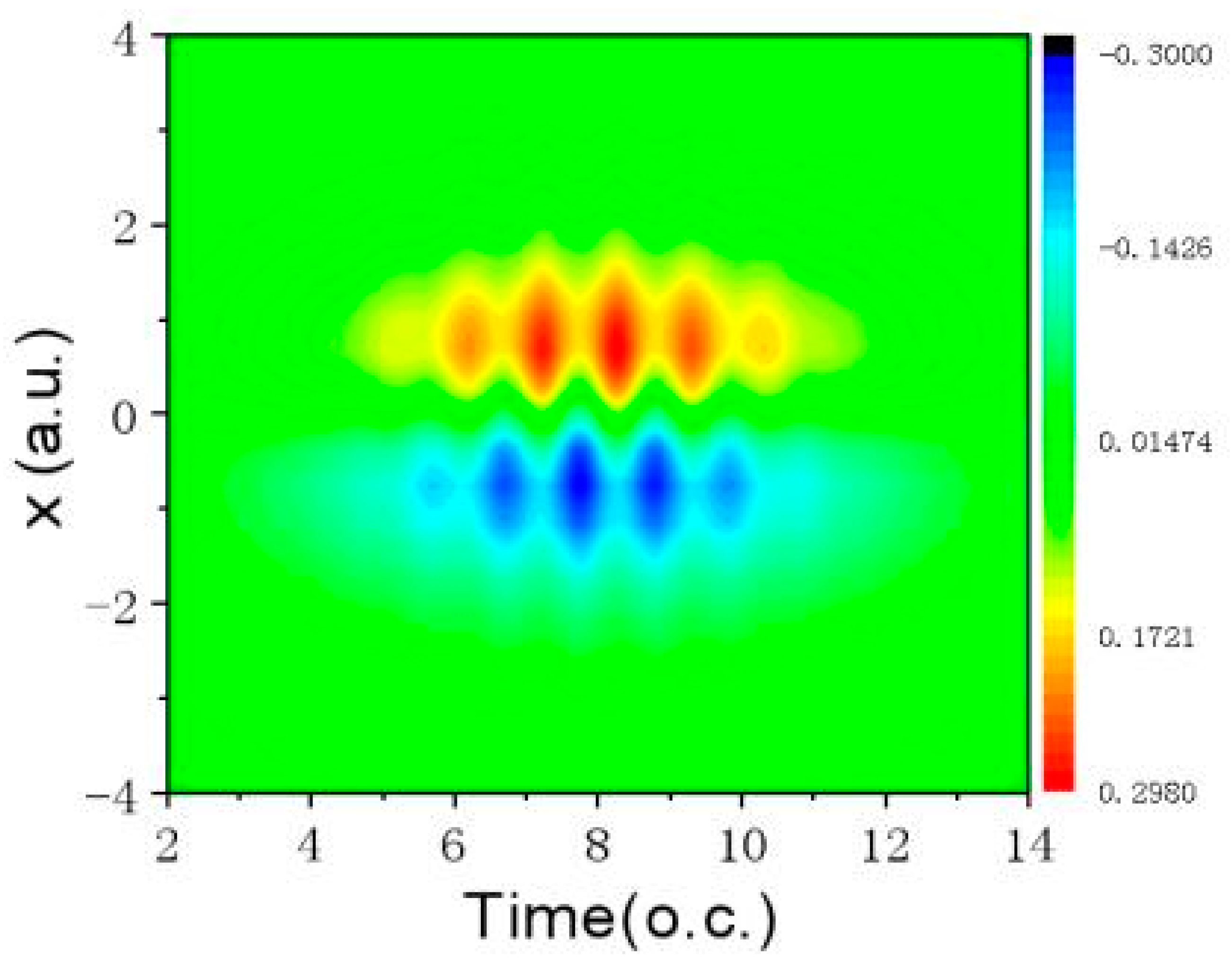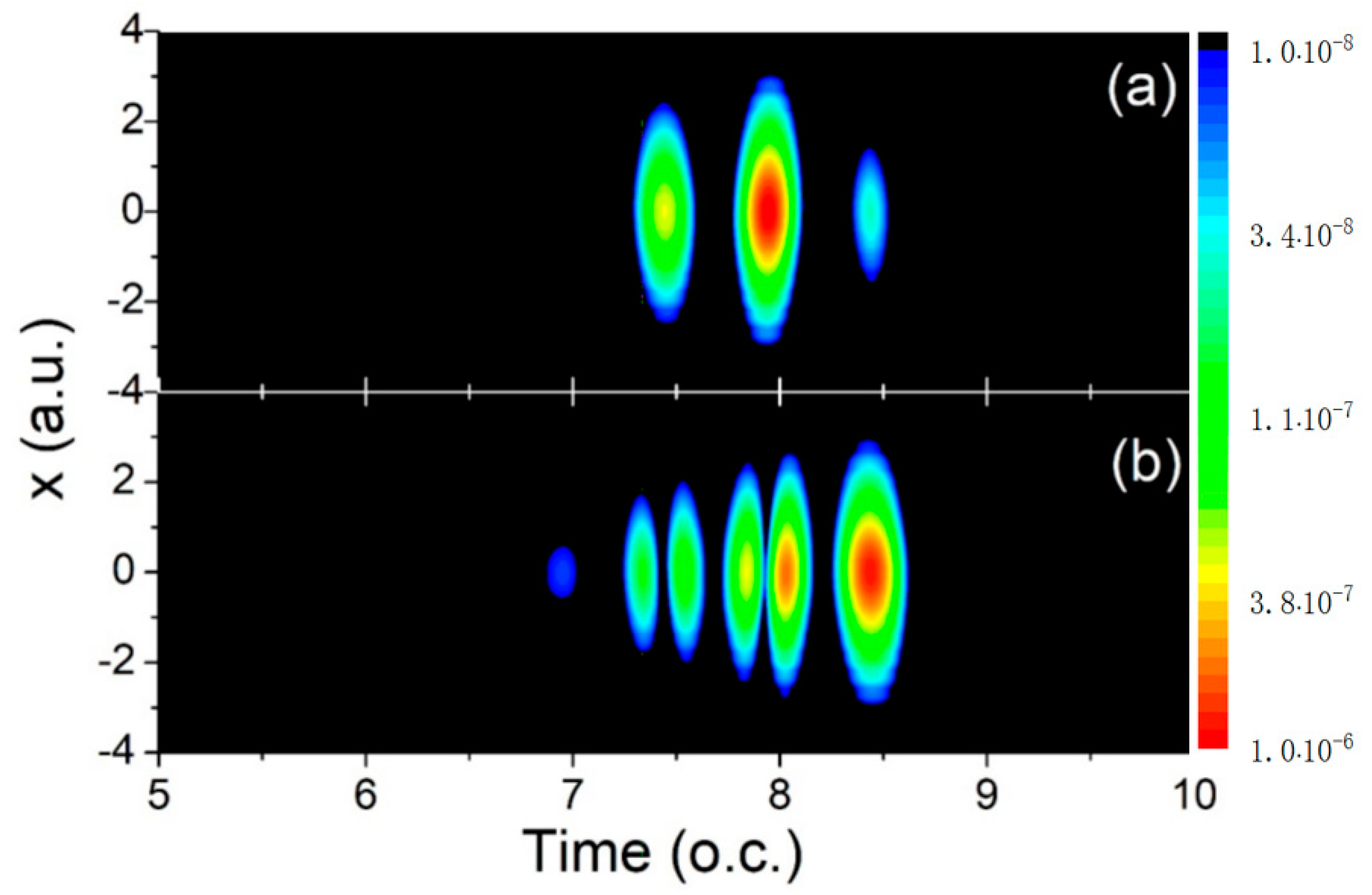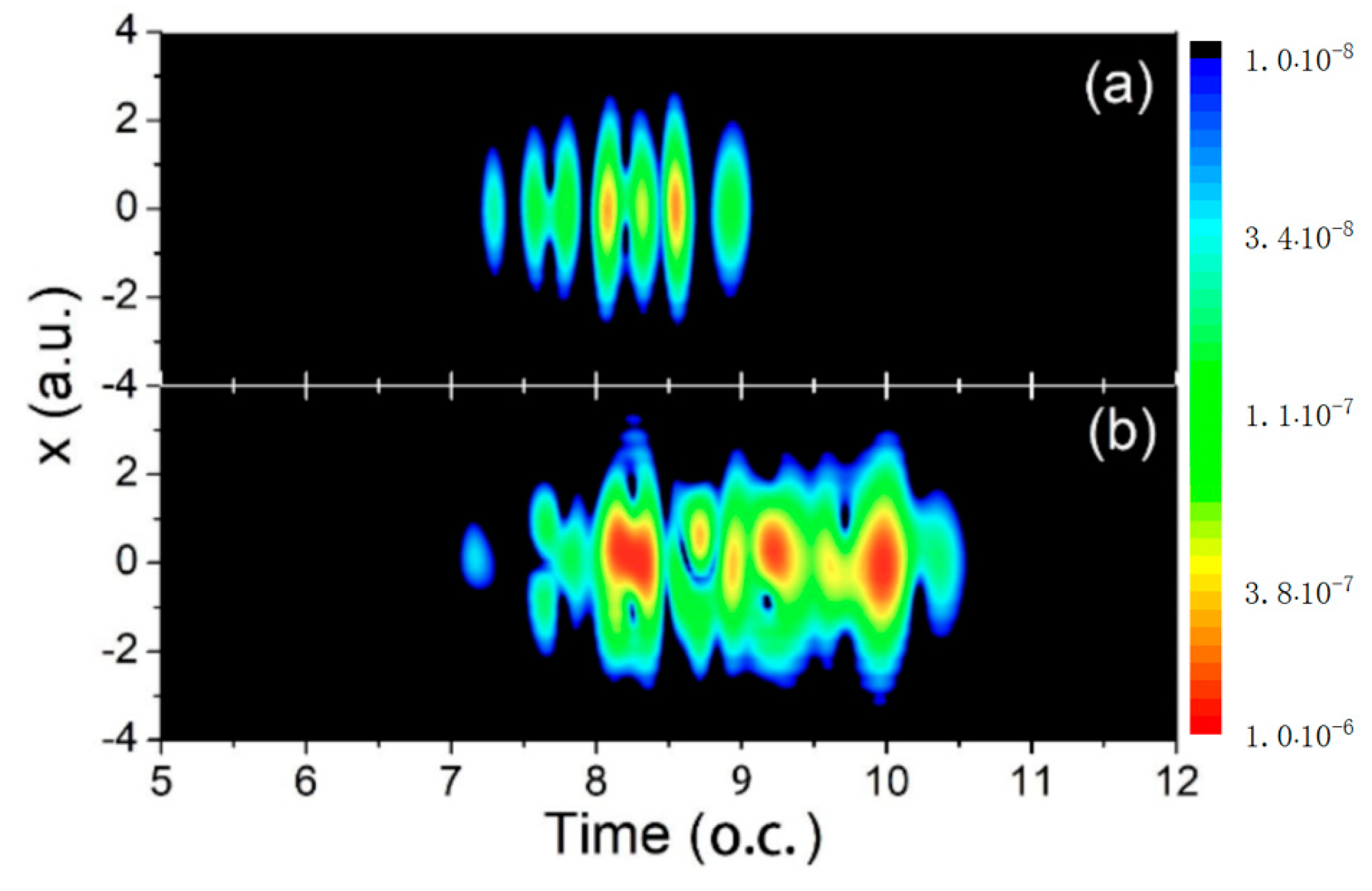Investigation of the Spatio-Temporal Characteristics of High-Order Harmonic Generation Using a Bohmian Trajectory Scheme
Abstract
:1. Introduction
2. Materials and Methods
3. Results and Discussion
4. Conclusions
Author Contributions
Funding
Institutional Review Board Statement
Informed Consent Statement
Data Availability Statement
Acknowledgments
Conflicts of Interest
References
- Yan, J.Z.; Zhao, S.S.; Lan, W.D.; Li, S.Y.; Zhou, S.S.; Chen, J.G.; Zhang, J.Y.; Yang, Y.J. Calculation of high-order harmonic generation of atoms and molecules by combining time series prediction and neural networks. Opt. Express 2022, 30, 35444–35456. [Google Scholar] [CrossRef]
- Yang, Y.J.; Chen, J.G.; Chi, F.P.; Zhu, Q.R.; Zhang, H.X.; Sun, J.Z. Ultrahigh harmonic generation from an atom with superposition of ground state and highly excited states. Chin. Phys. Lett. 2007, 24, 1537–1540. [Google Scholar]
- Krause, J.L.; Schafer, K.J.; Kulander, K.C. High-order harmonic generation from atoms and ions in the high intensity regime. Phys. Rev. Lett. 1992, 68, 3535. [Google Scholar] [CrossRef] [Green Version]
- Burnett, K.; Reed, V.; Knight, P. Atoms in ultra-intense laser fields. J. Phys. B At. Mol. Opt. Phys. 1993, 26, 561. [Google Scholar] [CrossRef]
- Krausz, F.; Ivanov, M. Attosecond physics. Rev. Mod. Phys. 2009, 81, 163. [Google Scholar] [CrossRef] [Green Version]
- Zhou, S.S.; Lan, W.D.; Chen, J.G.; Wang, J.; Guo, F.M.; Yang, Y.J. High-order harmonic generation of 1-nonene under linearly polarized laser pulses. Phys. Rev. A 2022, 106, 023510. [Google Scholar] [CrossRef]
- Itatani, J.; Levesque, J.; Zeidler, D.; Niikura, H.; Pépin, H.; Kieffer, J.C.; Corkum, P.B.; Villeneuve, D.M. Tomographic imaging of molecular orbitals. Nature 2004, 432, 867–871. [Google Scholar] [CrossRef]
- Vozzi, C.; Negro, M.; Calegari, F.; Sansone, G.; Nisoli, M.; De Silvestri, S.; Stagira, S. Generalized molecular orbital tomography. Nat. Phys. 2011, 7, 822–826. [Google Scholar] [CrossRef]
- van der Zwan, E.V.; Lein, M. Molecular imaging using high-order harmonic generation and above-threshold ionization. Phys. Rev. Lett. 2012, 108, 043004. [Google Scholar] [CrossRef]
- Hay, N.; de Nalda, R.; Halfmann, T.; Mendham, K.; Mason, M.; Castillejo, M.; Marangos, J. High-order harmonic generation from organic molecules in ultra-short pulses. Eur. Phys. J. D At. Mol. Opt. Plasma Phys. 2001, 14, 231–240. [Google Scholar] [CrossRef]
- Christov, I.P. Molecular dynamics with time dependent quantum Monte Carlo. J. Chem. Phys. 2008, 129, 214107. [Google Scholar] [CrossRef] [PubMed]
- Qiao, Y.; Huo, Y.Q.; Jiang, S.C.; Yang, Y.J.; Chen, J.G. All-optical reconstruction of three-band transition dipole moments by the crystal harmonic spectrum from a two-color laser pulse. Opt. Express 2022, 30, 9971–9982. [Google Scholar] [CrossRef] [PubMed]
- Jiang, S.; Yu, C.; Chen, J.; Huang, Y.; Lu, R.; Lin, C. Smooth periodic gauge satisfying crystal symmetry and periodicity to study high-harmonic generation in solids. Phys. Rev. B 2020, 102, 155201. [Google Scholar] [CrossRef]
- Qiao, Y.; Chen, J.; Chen, J. Review on the Reconstruction of Transition Dipole Moments by Solid Harmonic Spectrum. Symmetry 2022, 14, 2646. [Google Scholar] [CrossRef]
- Qiao, Y.; Huo, Y.; Liang, H.; Chen, J.; Liu, W.; Yang, Y.; Jiang, S. Robust retrieval method of crystal transition dipole moments by high-order harmonic spectrum. Phys. Rev. B 2023, 107, 075201. [Google Scholar]
- Gilbertson, S.; Khan, S.D.; Wu, Y.; Chini, M.; Chang, Z. Isolated attosecond pulse generation without the need to stabilize the carrier-envelope phase of driving lasers. Phys. Rev. Lett. 2010, 105, 093902. [Google Scholar] [CrossRef]
- Gibson, E.A.; Paul, A.; Wagner, N.; Tobey, R.; Gaudiosi, D.; Backus, S.; Christov, I.P.; Aquila, A.; Gullikson, E.M.; Attwood, D.T.; et al. Coherent soft X-ray generation in the water window with quasi-phase matching. Science 2003, 302, 95–98. [Google Scholar] [CrossRef]
- Cingöz, A.; Yost, D.C.; Allison, T.K.; Ruehl, A.; Fermann, M.E.; Hartl, I.; Ye, J. Direct frequency comb spectroscopy in the extreme ultraviolet. Nature 2012, 482, 68–71. [Google Scholar] [CrossRef] [Green Version]
- Qiao, Y.; Wu, D.; Chen, J.G.; Wang, J.; Guo, F.M.; Yang, Y.J. High-order harmonic generation from H 2+ irradiated by a co-rotating two-color circularly polarized laser field. Phys. Rev. A 2019, 100, 063428. [Google Scholar] [CrossRef]
- Eckle, P.; Pfeiffer, A.; Cirelli, C.; Staudte, A.; Dorner, R.; Muller, H.; Buttiker, M.; Keller, U. Attosecond ionization and tunneling delay time measurements in helium. Science 2008, 322, 1525–1529. [Google Scholar] [CrossRef]
- Schultze, M.; Ramasesha, K.; Pemmaraju, C.; Sato, S.; Whitmore, D.; Gandman, A.; Prell, J.S.; Borja, L.; Prendergast, D.; Yabana, K.; et al. Attosecond band-gap dynamics in silicon. Science 2014, 346, 1348–1352. [Google Scholar] [CrossRef]
- Kraus, P.M.; Mignolet, B.; Baykusheva, D.; Rupenyan, A.; Hornỳ, L.; Penka, E.F.; Grassi, G.; Tolstikhin, O.I.; Schneider, J.; Jensen, F.; et al. Measurement and laser control of attosecond charge migration in ionized iodoacetylene. Science 2015, 350, 790–795. [Google Scholar] [CrossRef] [PubMed] [Green Version]
- Hassan, M.T.; Luu, T.T.; Moulet, A.; Raskazovskaya, O.; Zhokhov, P.; Garg, M.; Karpowicz, N.; Zheltikov, A.; Pervak, V.; Krausz, F.; et al. Optical attosecond pulses and tracking the nonlinear response of bound electrons. Nature 2016, 530, 66–70. [Google Scholar] [CrossRef] [PubMed]
- Calegari, F.; Trabattoni, A.; Palacios, A.; Ayuso, D.; Castrovilli, M.C.; Greenwood, J.B.; Decleva, P.; Martín, F.; Nisoli, M. Charge migration induced by attosecond pulses in bio-relevant molecules. J. Phys. B At. Mol. Opt. Phys. 2016, 49, 142001. [Google Scholar] [CrossRef]
- Dong, F.; Tian, Y.; Yu, S.; Wang, S.; Yang, S.; Chen, Y. Polarization properties of below-threshold harmonics from aligned molecules H2+ in linearly polarized laser fields. Opt. Express 2015, 23, 18106–18116. [Google Scholar] [CrossRef]
- Goulielmakis, E.; Schultze, M.; Hofstetter, M.; Yakovlev, V.S.; Gagnon, J.; Uiberacker, M.; Aquila, A.L.; Gullikson, E.; Attwood, D.T.; Kienberger, R.; et al. Single-cycle nonlinear optics. Science 2008, 320, 1614–1617. [Google Scholar] [CrossRef] [Green Version]
- Qin, M.; Zhu, X.; Zhang, Q.; Lu, P. Tomographic imaging of asymmetric molecular orbitals with a two-color multicycle laser field. Opt. Lett. 2012, 37, 5208–5210. [Google Scholar] [CrossRef] [Green Version]
- Jiang, S.; Dorfman, K. Detecting electronic coherences by time-domain high-harmonic spectroscopy. Proc. Natl. Acad. Sci. USA 2020, 117, 9776–9781. [Google Scholar] [CrossRef]
- Corkum, P.B. Plasma perspective on strong field multiphoton ionization. Phys. Rev. Lett. 1993, 71, 1994. [Google Scholar] [CrossRef] [Green Version]
- Santra, R.; Gordon, A. Three-step model for high-harmonic generation in many-electron systems. Phys. Rev. Lett. 2006, 96, 073906. [Google Scholar] [CrossRef]
- Augstein, B.; de Morisson Faria, C.F. High-order harmonic generation in diatomic molecules: Quantum interference, nodal structures and multiple orbitals. Mod. Phys. Lett. B 2012, 26, 1130002. [Google Scholar] [CrossRef]
- Jin, C.; Le, A.T.; Lin, C. Medium propagation effects in high-order harmonic generation of Ar and N2. Phys. Rev. A 2011, 83, 023411. [Google Scholar] [CrossRef] [Green Version]
- Gaarde, M.B.; Tate, J.L.; Schafer, K.J. Macroscopic aspects of attosecond pulse generation. J. Phys. B At. Mol. Opt. Phys. 2008, 41, 132001. [Google Scholar] [CrossRef]
- Serebryannikov, E.; Zheltikov, A. Strong-field photoionization as excited-state tunneling. Phys. Rev. Lett. 2016, 116, 123901. [Google Scholar] [CrossRef] [PubMed]
- Heslar, J.; Chu, S.I. Ab initio study of high-lying doubly excited states of helium in static electric fields: Complex-scaling generalized pseudospectral method in hyperspherical coordinates. Phys. Rev. A 2012, 86, 032506. [Google Scholar] [CrossRef] [Green Version]
- Schneider, B.I.; Gharibnejad, H. Numerical methods every atomic and molecular theorist should know. Nat. Rev. Phys. 2020, 2, 89–102. [Google Scholar] [CrossRef]
- Geng, L.; Liang, H.; Peng, L.Y. Laser-Induced Electron Fresnel Diffraction in Tunneling and Over-Barrier Ionization. Chin. Phys. Lett. 2022, 39, 044203. [Google Scholar]
- Peng, Q.; Peng, Z.; Lang, Y.; Zhu, Y.; Zhang, D.; Lu, Z.; Zhao, Z. Decoherence Effects of Terahertz Generation in Solids under Two-Color Femtosecond Laser Fields. Chin. Phys. Lett. 2022, 39, 053301. [Google Scholar]
- Nishimura, K.; Xu, L.; Suda, A.; Midorikawa, K.; Fu, Y.; Takahashi, E.J. A Robust Scaling Up Method of Output Energy and Photon Energy on High-Order Harmonic Generation: Towards Sub-pJ Water Window Soft X-rays. CLEO: QELS_Fundamental Science. Opt. Soc. Am. 2020, 2020, FW4D–4. [Google Scholar]
- Lai, X.; Cai, Q.Y.; Zhan, M. From a quantum to a classical description of intense laser–atom physics with Bohmian trajectories. New J. Phys. 2009, 11, 113035. [Google Scholar] [CrossRef]
- Takemoto, N.; Becker, A. Visualization and interpretation of attosecond electron dynamics in laser-driven hydrogen molecular ion using Bohmian trajectories. J. Chem. Phys. 2011, 134, 074309. [Google Scholar] [CrossRef]
- Song, Y.; Guo, F.M.; Li, S.Y.; Chen, J.G.; Zeng, S.L.; Yang, Y.J. Investigation of the generation of high-order harmonics through Bohmian trajectories. Phys. Rev. A 2012, 86, 033424. [Google Scholar] [CrossRef]
- Wu, J.; Augstein, B.; de Morisson Faria, C.F. Local dynamics in high-order-harmonic generation using Bohmian trajectories. Phys. Rev. A 2013, 88, 023415. [Google Scholar] [CrossRef] [Green Version]
- Staudte, A.; Ruiz, C.; Schöffler, M.; Schössler, S.; Zeidler, D.; Weber, T.; Meckel, M.; Villeneuve, D.; Corkum, P.; Becker, A.; et al. Binary and recoil collisions in strong field double ionization of helium. Phys. Rev. Lett. 2007, 99, 263002. [Google Scholar] [CrossRef] [PubMed] [Green Version]
- Protopapas, M.; Keitel, C.H.; Knight, P.L. Atomic physics with super-high intensity lasers. Rep. Prog. Phys. 1997, 60, 389. [Google Scholar] [CrossRef]
- Song, Y.; Li, S.Y.; Liu, X.S.; Guo, F.M.; Yang, Y.J. Investigation of atomic radiative recombination processes by the Bohmian- mechanics method. Phys. Rev. A 2013, 88, 053419. [Google Scholar] [CrossRef]
- Bauschlicher, C.W.; Langhoff, S.R. The calculation of accurate harmonic frequencies of large molecules: The polycyclic aromatic hydrocarbons, a case study. Spectrochim. Acta Part A Mol. Biomol. Spectrosc. 1997, 53, 1225–1240. [Google Scholar] [CrossRef]
- Zhou, S.S.; Yang, Y.J.; Yang, Y.; Suo, M.Y.; Li, D.Y.; Qiao, Y.; Yuan, H.Y.; Lan, W.D.; Hu, M.H. High-order harmonic generation of the cyclo[18]carbon molecule irradiated by circularly polarized laser pulse. Chin. Phys. B 2022, 32, 013201. [Google Scholar] [CrossRef]
- Wang, J.; Chen, G.; Guo, F.M.; Li, S.Y.; Chen, J.G.; Yang, Y.J. High-intensity molecular harmonic generation without ionization. Chin. Phys. B 2013, 22, 033203. [Google Scholar] [CrossRef]
- Tian, Y.Y.; Li, S.Y.; Wei, S.S.; Guo, F.M.; Zeng, S.L.; Chen, J.G.; Yang, Y.J. Investigation on the influence of atomic potentials on the above threshold ionization. Chin. Phys. B 2014, 23, 053202. [Google Scholar] [CrossRef]
- Wei, S.S.; Li, S.Y.; Guo, F.M.; Yang, Y.J.; Wang, B. Dynamic stabilization of ionization for an atom irradiated by high-frequency laser pulses studied with the Bohmian-trajectory scheme. Phys. Rev. A 2013, 87, 063418. [Google Scholar] [CrossRef]





Disclaimer/Publisher’s Note: The statements, opinions and data contained in all publications are solely those of the individual author(s) and contributor(s) and not of MDPI and/or the editor(s). MDPI and/or the editor(s) disclaim responsibility for any injury to people or property resulting from any ideas, methods, instructions or products referred to in the content. |
© 2023 by the authors. Licensee MDPI, Basel, Switzerland. This article is an open access article distributed under the terms and conditions of the Creative Commons Attribution (CC BY) license (https://creativecommons.org/licenses/by/4.0/).
Share and Cite
Song, S.; Wu, L.; Qiao, Y.; Zhou, S.; Wang, J.; Guo, F.; Yang, Y. Investigation of the Spatio-Temporal Characteristics of High-Order Harmonic Generation Using a Bohmian Trajectory Scheme. Symmetry 2023, 15, 581. https://doi.org/10.3390/sym15030581
Song S, Wu L, Qiao Y, Zhou S, Wang J, Guo F, Yang Y. Investigation of the Spatio-Temporal Characteristics of High-Order Harmonic Generation Using a Bohmian Trajectory Scheme. Symmetry. 2023; 15(3):581. https://doi.org/10.3390/sym15030581
Chicago/Turabian StyleSong, Simeng, Linyan Wu, Yue Qiao, Shushan Zhou, Jun Wang, Fuming Guo, and Yujun Yang. 2023. "Investigation of the Spatio-Temporal Characteristics of High-Order Harmonic Generation Using a Bohmian Trajectory Scheme" Symmetry 15, no. 3: 581. https://doi.org/10.3390/sym15030581
APA StyleSong, S., Wu, L., Qiao, Y., Zhou, S., Wang, J., Guo, F., & Yang, Y. (2023). Investigation of the Spatio-Temporal Characteristics of High-Order Harmonic Generation Using a Bohmian Trajectory Scheme. Symmetry, 15(3), 581. https://doi.org/10.3390/sym15030581




